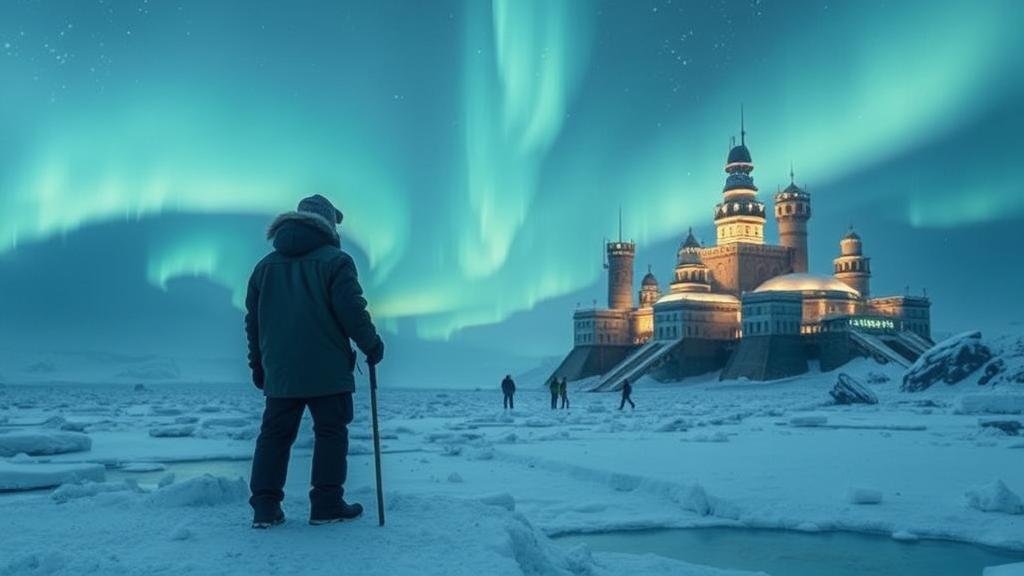Investigating the “City of Eternal Twilight,” a rumored metropolis under Scandinavia’s ice sheets.
Investigating the City of Eternal Twilight
Deep beneath the vast ice sheets of Scandinavia lies an enigma that has captured the imagination of explorers and historians alike: the rumored City of Eternal Twilight. This alleged metropolis, thought to be buried beneath layers of ice for centuries, raises questions about ancient civilizations and their adaptations to extreme climates.
Historical Context of Scandinavia’s Ice Sheets
The Scandinavian ice sheets, particularly the Greenland Ice Sheet, are some of the largest in the world, covering approximately 1.7 million square kilometers. This formidable expanse of ice has been formed over millennia, dating back to around 2.4 million years ago during the Quaternary glaciation. The thick ice covers many geological and potentially human-made structures, leading to speculation about hidden cities.
Origins of the Legend
The legend of the City of Eternal Twilight has its roots in local folklore and the tales of early explorers. In the early 20th century, adventurers reported seeing strange formations and hearing echoes of what they believed might be ancient structures as they traversed the icy terrain. This sparked interest among archaeologists and historians, leading to expeditions aimed at uncovering the truth behind these stories.
Scientific Investigations
Recent technological advancements have facilitated the search for hidden structures beneath the ice. Ground-penetrating radar (GPR) and aerial LIDAR are among the techniques used to survey the ice sheets.
- Ground-Penetrating Radar (GPR): This technology sends radar waves into the ice, which bounce back from structures, revealing their size and shape.
- Aerial LIDAR: This method uses laser pulses to map the surface and can detect variations in topography that might suggest the presence of artificial constructions.
In 2020, researchers from the University of Oslo reported intriguing findings of potential buried structures beneath the ice. Although the results are not conclusive, they have ignited further speculation regarding the existence of this mythical city.
Possible Theories About the City
There are several hypotheses regarding the origin and function of the alleged City of Eternal Twilight:
- Ancient Civilizations: Some experts believe the city could be remnants of ancient Norse settlements that thrived before the onset of the current ice age.
- Mythological Roots: Others argue that the city is a product of myth and legend, inspired by Norse mythology which often speaks of hidden realms and lost civilizations.
- Extraterrestrial Influences: A fringe theory posits that the structures may be of extraterrestrial origin, adding a science fiction twist to the legend.
Modern Implications and Comparisons
While the existence of the City of Eternal Twilight remains unverified, its investigation underlines a broader issue facing archæology today: the effects of climate change on historical sites. As glacier melt accelerates, previously hidden artifacts and structures may emerge, offering new opportunities–and challenges–for researchers.
Comparatively, other archaeological discoveries, such as the Ice Age settlements in Alaska and the frozen bodies found in the Alps, highlight how ice can preserve ancient civilizations. These comparisons increase interest in Scandinavian ice as a potential reservoir of ancient human history.
Conclusion: What Lies Ahead
As exploration techniques continue to evolve, the search for the City of Eternal Twilight persists, powered by a blend of historical curiosity and technological advancement. While definitive evidence remains elusive, the ongoing investigation serves as a reminder of the mysteries that lie right beneath our feet, frozen in time.
To wrap up, whether the City of Eternal Twilight is a myth or reality, the pursuit of knowledge about our past encourages us to explore, question, and learn. Future explorations are likely to reveal more about the ice-covered landscapes, potentially rewriting our understanding of ancient civilizations and their adaptability to harsh environments.
Actionable Takeaway: Follow ongoing research and technological advancements in archaeology to stay informed about potential discoveries in the realm of ancient ice-covered civilizations.



